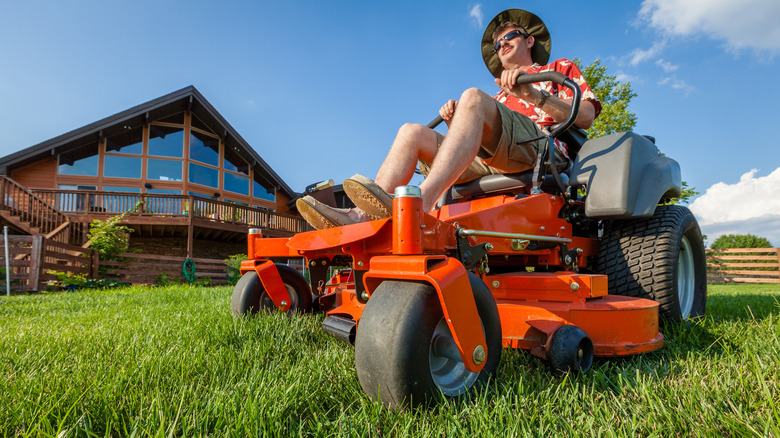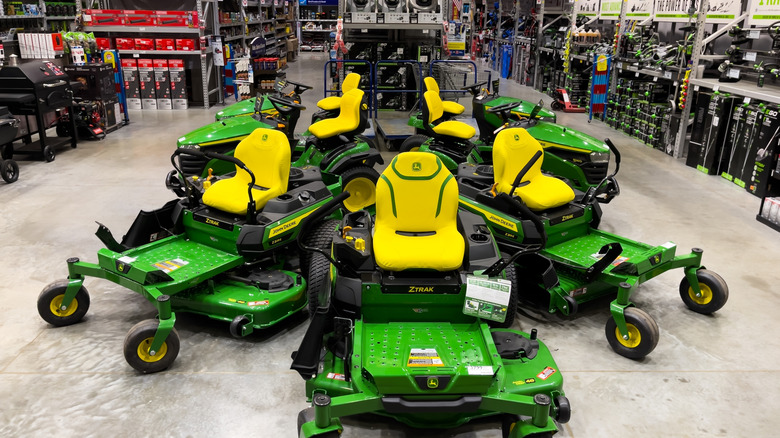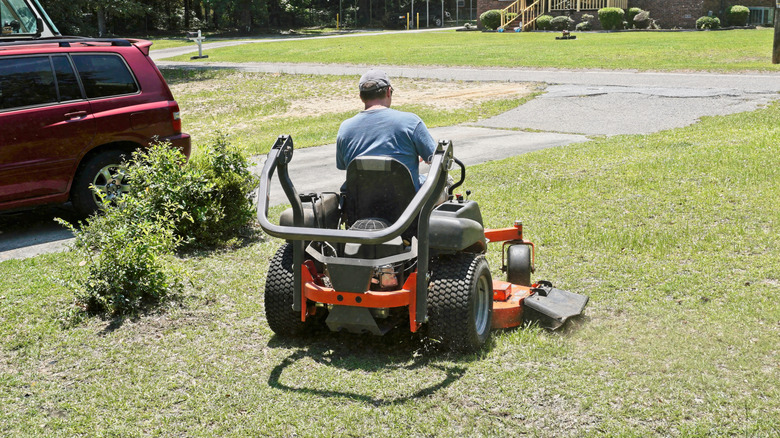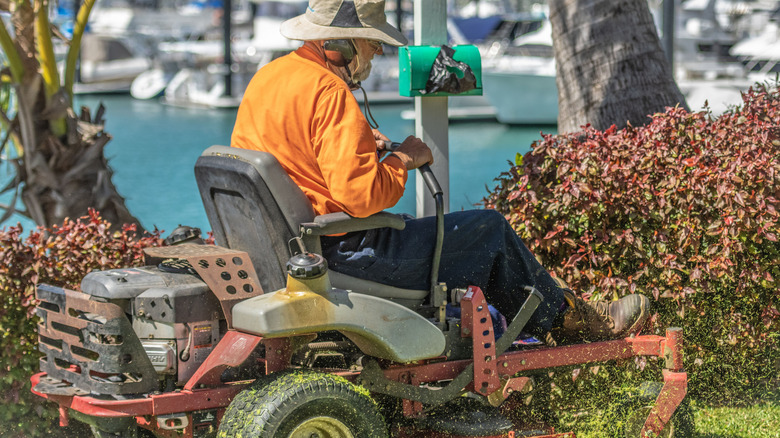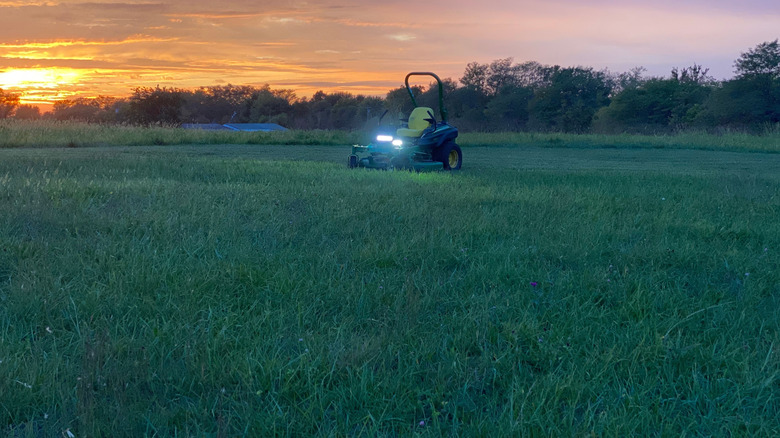The Hidden Downsides To Zero-Turn Lawn Mowers
Wouldn't it be cool to zip to work or to the supermarket in a Formula I car rather than your Camry? All that speed, power, and maneuverability would make the most mundane errand exciting. At least, if you don't consider the expense, the nights in jail, and all the hospital bills. For some of us, a zero-turn mower is roughly analogous to driving an F1 car to pick up cat food: expensive, dangerous, and not really designed for what we're trying to do.
Of course, it's possible that you have just the right lawn for a zero-turn mower: spacious, full of obstacles that are difficult to cut around, and flat — very flat, or at least with hills that roll gently across the fairway to the green. That's great, because you can no longer afford a golf cart after buying a zero-turn mower. But don't fret about being embarrassed around your golfing buddies; you'll be off the course and en route to the hospital soon enough.
The fact is that zero-turn mowers are awesome. They're also a little expensive, a little hard to drive, bad at stopping, good at colliding, and probably too big to really be the best type of mower for your small yard. Let's take a look at these, starting with the issue that even the most optimistic consumer can't rationalize away ... the price.
The high cost of a zero-turn mower
The first thing you'll notice about the cost of a zero-turn mower is that your dad's reaction to the price would be an emphatic, "For a lawnmower?" Yes, they're pricey ... somewhere between $2,700 and $20,000. You can get a residential Murray from Home Depot for less than $3,000 or a Scag commercial Turf Tiger for a little less than a Kia Soul. To be sure, zero-turn mowers require a substantial initial investment, but you might be hoping that extra money pays off in some way. They're expensive at first, but perhaps they sniff out truffles or are so fuel efficient and maintenance-free that you'll actually save money.
Nope. Zero-turn mowers, with their hydrostatic transmissions, are more complex than your usual lawn tractor. All that complexity has cost implications. Maintenance and repair parts can be expensive and difficult to come by. And there's an increased chance you'll need a professional to do the maintenance than you would with, say, a $300 push mower. These are also advanced, fast machines, which means high fuel consumption. And they have complicated electrical systems which, in many cases, means you might experience more frequent (and costly) electrical failures. Some models, for example, are kind of famous for ignition problems.
Some argue you might make up some of the cost difference with the time you save using a zero-turn. That might be true if you charge more for your time than a Silicon Valley lawyer. But however you justify it, don't shortcut proper maintenance. A poorly maintained zero-turn will be a source of constant cash outlay.
Terrain limitations on bumpy areas with lots of obstacles
Let's assume you have money to zero-burn and a pretty big yard. Sounds like you're in the market for a new mower! But we need more information for our checklist. Does your yard have uneven patches? Zero-turn mowers don't handle bumpy terrain well. Consider, for example, the front wheels — glorified shopping cart casters — that do little more than make the mower unstable. Are you ever tempted to mow your lawn when it's a bit wet ... say, in the dewy early morn? It's one of the mistakes everyone makes when mowing, but definitely resist the temptation with zero-turn mowers, which have famously bad traction on wet grass.
Are there any objects in or around your lawn that you'd rather not crash into ... say, that Camry or your natural gas hookup? If so, you should know that zero-turns are difficult to stop. In fact, they don't have what you'd call brakes. You read that right. There's no brake pedal. Instead, returning the handles to neutral stops the mower. Are there any toys in your yard? Or rocks, or ... well, anything? In spite of being designed for agility, zero-turns are terrible at handling obstacles and have unusually little ground clearance. So they might not pass over those little items in your yard that are difficult to spot.
The lack of maneuverability, brakes, and ground clearance is problematic on hills, as you might imagine. If your lawn has any actual slopes more than, say, 10 degrees, a zero-turn mower is out of the question, though there will be questions about your health insurance. Zero-turn mowers are difficult to steer on hills and are prone to overturning, but we'll come back to that.
Zero-turn mower safety concerns, including roll-overs and poor traction
The quirks that make zero-turn mowers challenging to handle on anything but flat terrain also tend to make these mowers substantially more dangerous than traditional riding or walk-behind mowers. Slippery or sloped terrain contributes to rollovers, and if there's one thing you don't want to be under it's a lawnmower. Traction problems, especially among lighter-weight models and consumer models with less grip, exacerbate this tendency to be upended. And their higher speeds contribute to this issue, as well. Don't buy a zero-turn without a rollover protection system, unless you're an experienced user. For what it's worth, models with rollover protection start at around $6,300.
Even if you're perfectly safe belted into your perch above the mower deck, that doesn't mean everyone around you is safe as well. As we said, zero-turn mowers are more prone to collisions for a variety of reasons, but they also have a habit of tossing debris around your property at the speed of lawnmower blades. Some have suggested wearing hard hats when working around zero-turn mowers, and that should tell you a little something about what we're dealing with.
Difficulty learning how to use a zero-turn mower
This one almost goes without saying, given all of the problems zero-turn mowers have with traction, stability, and keeping their tops on top. But you should know that there's a somewhat steep learning curve for zero-turn novices ... and we already know what to expect from these mowers when it comes to steep things. What about curves? Despite being designed to navigate around objects — "turn" is in their name, after all — this skill can take time to master. Zero-turn mowers steer by the relative speed and direction of their rear tires, which don't turn. Instead, you use a two-lap bar steering and acceleration mechanism that controls the wheels independently. This system is where the "zero-turn" aspect comes from and might be familiar if you've driven a tank or an excavator. It's not intuitive without experience. It isn't terribly difficult to get the hang of, but it will take some time and adjustments.
Zero-turn mowers also have a high center of gravity and make rather dramatic turns, so inertia tends to treat your body a little unexpectedly at times. And remember the lack of traditional brakes? There is (of course) a kind of braking mechanism that kicks in when you put both lap bars in their center, neutral position, but rather than being a hard braking that you can influence with force, it's a relatively gradual braking that most would describe as "slowing down" instead. And, finally, the high speeds make a consistent cut challenging, so allow yourself some time for mastering that skill as well.
Too big for small lawns
However you feel about your driving skills, your bank account, and the quality of your life insurance, there's one more factor that might be a deal-breaker when it comes to buying (or not) a zero-turn mower: They just aren't well-suited to smaller lawns. You'll get annoyed (to say nothing of carsick) dodging obstructions every 10 feet. This isn't helped by their speed, which can be excessive in a tiny suburban yard. Then there's the size. What's the distance between that concrete angel statue and the walkway? How about the bird feeder and the fire pit? Any two things in your yard will require that you navigate a zero-turn mower between them ... if it's even possible.
A half-acre lot is a good minimum size that might benefit from (but certainly wouldn't require) a zero-turn mower. If you have many garden beds and other distractions interrupting your grass farm, you'll want to consider a traditional riding or walk-behind mower for a half-acre lot. A smaller mower deck can also mitigate these concerns ... while also increasing the amount of time it takes you to mow. There's no getting around the challenges of getting around things when you're mowing.
